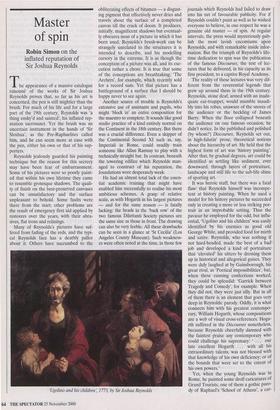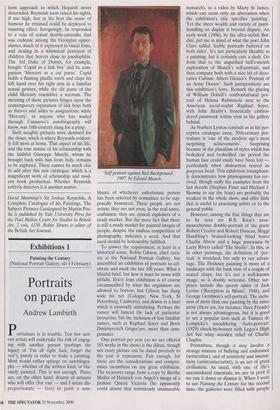Master of spin
Robin Simon on the inflated reputation of Sir Joshua Reynolds
The appearance of a massive catalogue raisonne of the works of Sir Joshua Reynolds proves that, so far as his art is concerned, the pen is still mightier than the brush. For much of his life and for a large part of the 19th century, Reynolds was 'a thing ensky'd and sainted', his inflated rep- utation sacrosanct. Yet the brush was an uncertain instrument in the hands of 'Sir Sloshua', as the Pre-Raphaelites called him, and he can seem more at ease with the pen, either his own or that of his sup- porters.
Reynolds jealously guarded his painting technique but the reason for this secrecy may have been fear of embarrassment. Some of his pictures were so poorly paint- ed that within his own lifetime they came to resemble grotesque shadows. The quali- ty of finish on the best-preserved canvases can be unsatisfactory and the surface unpleasant to behold. Some faults were there from the start; other problems are the result of emergency first aid applied by restorers over the years, with their abra- sives, flat irons and relinings.
Many of Reynolds's pictures have suf- fered from fading of the reds, and the typi- cal Reynolds face has a deathly pallor about it. Others have succumbed to the obliterating effects of bitumen — a disgust- ing pigment that effectively never dries and travels about the surface of a completed canvas till the crack of doom. It produces, initially, magnificent shadows but eventual- ly obscures most of a picture in which it has been used. Reynolds's brush-work can be strangely unrelated to the structures it is intended to describe, and his modelling cursory in the extreme. It is as though the conception of a picture was all, and its exe- cution rather a chore. It is true that some of the conceptions are breathtaking: 'The Archers', for example, which recently sold for a record sum. Yet that picture has a battleground of a surface that I should be happy never to see again.
Another source of trouble is Reynolds's extensive use of assistants and pupils, who might 'block in' an entire composition for the maestro to complete. It sounds like good studio practice of a kind entirely normal on the Continent in the 18th century. But there was a crucial difference. Even a skipper of the Continental Second XI such as, say, Imperiali in Rome, could readily train someone like Allan Ramsay to play with a technically.straight bat. In contrast, beneath the towering edifice which Reynolds man- aged to construct of his reputation, the foundations were desperately weak.
He had an almost total lack of the essen- tial academic training that might have enabled him successfully to realise his most ambitious schemes. A grasp of relative scale, as with Hogarth in his largest pictures — and for the same reason — is fatally lacking: the heads in the 'back row' of the two famous Dilettanti Society pictures are the same size as those in front. The drawing can also be very feeble. All these drawbacks can be seen in a glance at 'St Cecilia' (Los Angeles County Museum). Such weakness- es were often noted at the time, in those few Vgolino and his children' 1773, by Sir Joshua Reynolds journals which Reynolds had failed to draw into his net of favourable publicity. For if Reynolds couldn't paint as well as he wished everyone to believe,. in one respect he was a genuine old master — of spin. At regular intervals, the press would mysteriously pub- lish the most lavish encomiums upon Reynolds, and with remarkable inside infor- mation. But the triumph of Reynolds's life- time dedication to spin was the publication of the famous Discourses, the text of lec- tures that he delivered, in his capacity as its first president, to a captive Royal Academy.
The reality of these lectures was very dif- ferent from the reverential legends that grew up around them in the 19th century. Reynolds, stone deaf, armed with an inade- quate ear-trumpet, would mumble inaudi- bly into his robes, unaware of the snores of the audience or the heckling of James Barry. When the floor collapsed beneath the audience on one famous occasion, he didn't notice. In the published and polished (by whom?) Discourses, Reynolds set out, in high-falutin' prose, theoretical notions about the hierarchy of art. He held that the highest form of art was 'history painting'. After that, by gradual degrees, art could be identified as settling like sediment, ever downward, through layers of portraiture, landscape and still life to the sub-life slime of sporting art.
It was heroic stuff, but there was a fatal flaw: that Reynolds himself was incompe- tent at history painting. When he used a model for his history pictures he succeeded only in creating a more or less striking por- trait in an improbable setting. Thus the paviour he employed for the odd, but influ- ential, rUgolino and his children' was easily identified by his enemies as good old George White, and provided food for mirth and satire. Reynolds, who was nothing if not hard-headed, made the best of a bad job and developed a kind of portraiture that 'elevated' his sitters by dressing them up in historical and allegorical guises. They were duly laughed at by Gainsborough, his great rival, as 'Poetical impossibilities', but, when these cunning confections worked, they could be splendid: 'Garrick between Tragedy and Comedy', for example. When they did not, they were just silly. But in all of them there is an element that goes very deep in Reynolds: parody. Oddly, it is what connects him with his greatest contempo- rary, William Hogarth, whose compositions are a web of visual cross-references. Hoga- rth suffered in the Discourses nonetheless, because Reynolds cheerfully damned with the faintest praise any contemporary who could challenge his supremacy: . . . our late excellent Hogarth . . . with all his extraordinary talents, was not blessed with that knowledge of his own deficiency; or of the bounds that were set to the extent of his own powers.' • Yet, when the young Reynolds was in Rome, he painted some droll caricatures of Grand Tourists, one of them a gothic paro- dy of Raphael's 'School of Athens', a car- toon approach to which Hogarth never descended. Reynolds soon raised his sights, if too high, but at his best the sense of humour he retained could be deployed to stunning effect. Intriguingly, he responded to a vein of sexual double-entendre that was endemic among the Georgian upper- classes, much of it expressed in visual form, and dealing in a whimsical portrayal of children that hovers close to paedophilia. The 3rd Duke of Dorset, for example, bought 'Cupid as a link boy' and its com- panion 'Mercury as a cut purse'. Cupid holds a flaming phallic torch and claps his left hand over his right arm in a familiar sexual gesture, while the slit purse of the child Mercury resembles a scrotum. The meaning of these pictures hinges upon the contemporary reputation of link boys both as thieves and aides to assignations; while `Mercury', as anyone who has waded through Casanova's autobiography will know, was 18th-century slang for a pimp.
Such naughty pictures were destined for the closet, which is where Reynolds evident- ly felt most at home. That aspect of his life, and the true nature of his relationship with the faithful Giuseppe Marchi, whom he brought back with him from Italy, remains to be explored. There cannot be much else to add after this new catalogue, which is a magnificent work of scholarship and mod- ern book production. Whether Reynolds entirely deserves it is another matter.
David Mannings's Sir Joshua Reynolds, A Complete Catalogue of his Paintings, The Subject Pictures Catalogued by Martin Pos- tle is published by Yale University Press for the Paul Mellon Centre for Studies in British Art, 2 vols, £150. Robin Simon is editor of the British Art Journal.






























































































 Previous page
Previous page